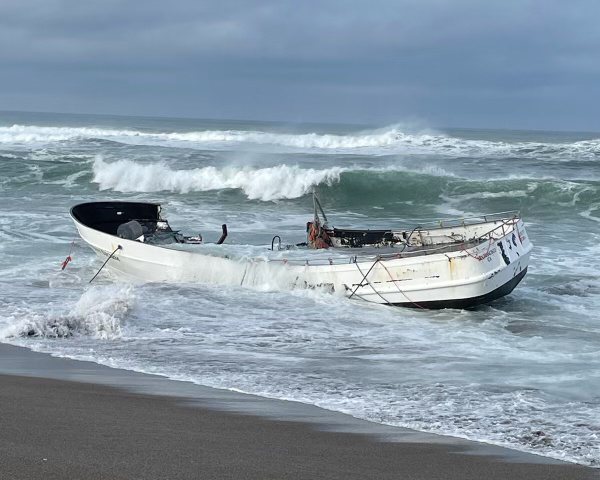Incident Responses for February 2024
[ad_1]
On February 9, the USCG contacted the NOAA scientific support coordinator (SSC) for Alaska, regarding a spill of diesel from a bulk fuel site in the southwest Alaska community of Kwigillingok.
Preliminary reports showed that 2,000 gallons of diesel had been discharged into secondary containment, but that figure was adjusted to 9,000 gallons over time. The release occurred during a fuel transfer from a larger storage tank to a smaller one. Responders were actively recovering free liquids and deployed absorbent booms and pads to stop the spill’s spread.
The area impacted by the diesel included snow and ice-covered tundra and a pond in the immediate vicinity of the tank farm. The diesel had not spread to the Kwigillingok River, about 150 feet from the tank farm, nor the housing south of the tank farm.
USCG requested NOAA’s assistance in identifying the resources at risk and in initiating emergency Endangered Species Act (ESA) consultation. The Kwigillingok River is a tidal river, with the spill approximately three miles upstream from Kuskokwim Bay. Two ESA-listed threatened waterfowl species (Spectacled and Steller’s Eiders) are not currently in the area, but they are expected to return with the spring migration. Additionally, two threatened seal species are found in Kuskokwim Bay and potentially within the river, although not at this time of year. The Kuskokwim River Delta is a globally recognized Important Bird Area (IBA), and its vegetated intertidal areas support some of the highest nesting densities of shorebirds in the world. Fortunately, most bird species have not yet arrived on their nesting grounds, but impacts to nesting sites from fuel contamination or recovery efforts may affect nesting birds and their eggs in the spring. The spill is also located within the historic boundaries of the Yukon Delta National Wildlife Refuge.
Alaska Department of Fish and Game has documented that residents of Kwigillingok and other communities in the Yukon-Kuskokwim Delta coast conduct subsistence activities in the region throughout the year, including fishing and harvesting of marine mammals.
On-scene responders are dealing with challenges often associated with small remote communities: lack of heavy equipment; limited lodging (e.g., commuting daily from Bethel); limited internet and cellular communications; and severe winter weather. In the two weeks post discharge, the area received 24-30” of snow.
The Alaska Department of Environmental Conservation (ADEC), the USCG, and other state and federal agencies will continue to assist with developing response actions for the cleanup, develop tactics to maximize the reuse of recovered diesel fuel, and minimize damage to the environment.
Due to extreme weather conditions, the remote location, and resource-constrained logistics, recovery of the diesel has been limited. Site operations largely focused on delineation of the contaminated area and constructing snow berms and trenches in the snow to contain and collect the diesel when the snow begins to melt in late April through May.
As of March 12, responders have been demobilized. Wildlife agencies are working on a bird deterrent and hazing strategy. Responders will return to the site in spring to continue recovery and containment tactics.
Grounded Fishing Vessel in Bodega Bay, California

On February 10, the USCG contacted the NOAA SSC for California to report the grounding of a 58-foot fishing vessel, Aleutian Storm, near Salmon Creek, just north of Bodega Bay, California. Grounded on a sandy beach amidst the surf, the vessel did not appear to have sustained any damage, and no sheening or pollution was observed. The vessel had a pollution potential of 3,500 gallons of diesel; however, a lower volume was estimated to be on board. The four persons on board were safely evacuated.
The USCG sought oil fate and transport information from NOAA in the event of a diesel release prior to or during vessel salvage operations. NOAA provided a trajectory indicating that any potential product discharge would remain in the surf zone.
Located on California State Parks property, the grounded vessel was near two environmentally sensitive sites and within the Greater Farallones National Marine Sanctuary. The Coast Guard established a Unified Command that included NOAA, California Department of Fish and Wildlife Office of Spill Prevention and Response (CDFW-OSPR), California State Parks, Sonoma County Sheriff’s Department, and the vessel captain.
The following day, efforts to refloat the vessel at high tide were unsuccessful. When safe working conditions allowed, attempts to remove pollution from the vessel, address the crab catch onboard, and assess the vessel’s integrity continued; however, efforts to refloat or relocate the vessel further up the beach were unsuccessful.

The Unified Command determined that pollution removal operations would be unsafe due to weather conditions and the degraded condition of the vessel and shifted plans to a salvage operation.
On February 19, the USCG and CDFW-OSPR transitioned the authority of lead responding agency to NOAA’s Greater Farallones National Marine Sanctuary, which is leading oversight of the salvage operations in coordination with state and local agencies and the vessel’s owner.
[ad_2]


